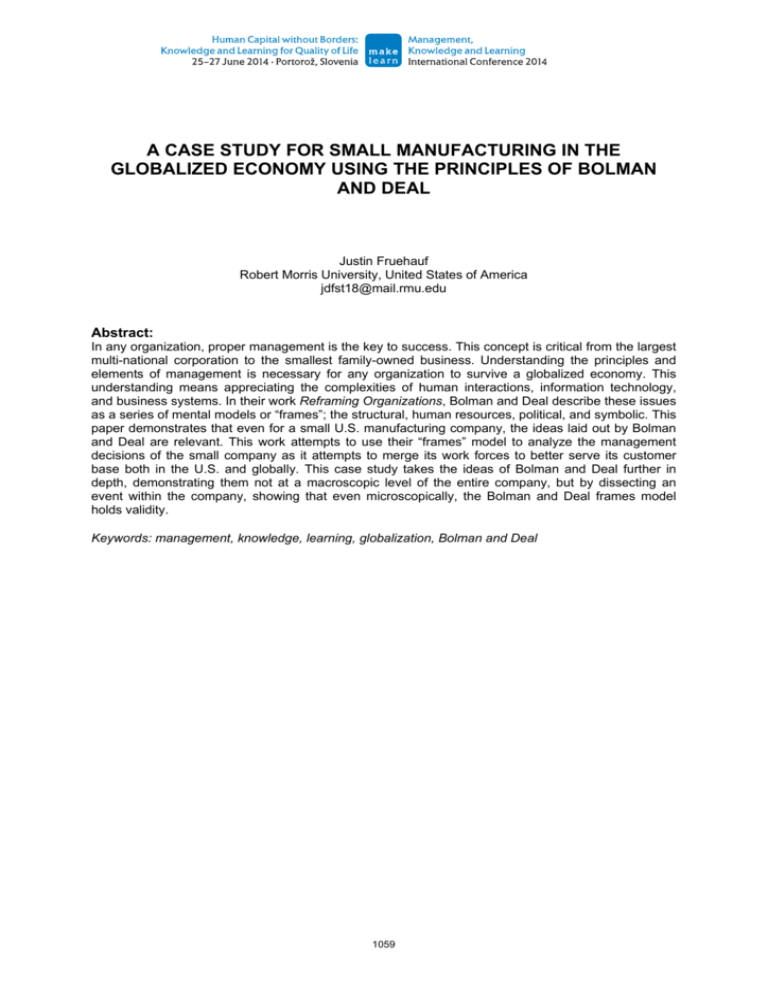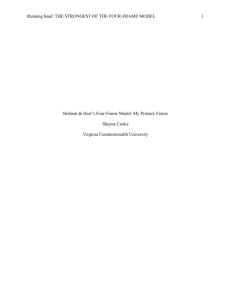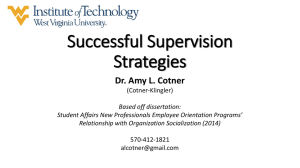Full Text - ToKnowPress
advertisement

A CASE STUDY FOR SMALL MANUFACTURING IN THE GLOBALIZED ECONOMY USING THE PRINCIPLES OF BOLMAN AND DEAL Justin Fruehauf Robert Morris University, United States of America jdfst18@mail.rmu.edu Abstract: In any organization, proper management is the key to success. This concept is critical from the largest multi-national corporation to the smallest family-owned business. Understanding the principles and elements of management is necessary for any organization to survive a globalized economy. This understanding means appreciating the complexities of human interactions, information technology, and business systems. In their work Reframing Organizations, Bolman and Deal describe these issues as a series of mental models or “frames”; the structural, human resources, political, and symbolic. This paper demonstrates that even for a small U.S. manufacturing company, the ideas laid out by Bolman and Deal are relevant. This work attempts to use their “frames” model to analyze the management decisions of the small company as it attempts to merge its work forces to better serve its customer base both in the U.S. and globally. This case study takes the ideas of Bolman and Deal further in depth, demonstrating them not at a macroscopic level of the entire company, but by dissecting an event within the company, showing that even microscopically, the Bolman and Deal frames model holds validity. Keywords: management, knowledge, learning, globalization, Bolman and Deal 1059 1. INTRODUCTION In Reframing Organizations Lee Bolman and Terrence Deal hypothesize that organizations can be viewed and analyzed through a series of mental models or ideas and assumptions. People use these models to negotiate and comprehend the entity or territory. Bolman and Deal use the term “frames” to represent the mental models. (Bolman and Deal, 2008) In particular the authors surmised that organizations can be viewed through four major frames: structural, human resources, political, and symbolic. (Bolman and Deal, 2008). Using this model to analyze a small manufacturing company located in the United States would require time and effort well outside the scope this project. Much like Bolman and Deal use case studies to extrapolate their frame theory, it is possible to apply this strategy to a particular instance or event in an organization creating a snapshot for analysis. In this case study, this event is the facility move and consolidation of a small family-owned manufacturing company located in the northeast United States. Regardless of the size of a company, an undertaking such as this represents a great deal of effort. This paper will focus on the application of Bolman and Deal’s model to analyze the impact of the merger of the two sales departments into one entity. The author notes the existence of a great deal of written criticisms of the Bolman and Deal model. While recognizing these critiques, the focus of this paper is the application of the Bolman and Deal model to the above mentioned case study. Currently the company is divided into two physical locations. The first location is dedicated to the production and assembly of a product line focused on industrial furnace safety equipment (hereafter referred to as AM). The second location is a custom-machining center containing modern CNC machinery (hereafter referred to as CNC). CNC supports AM’s machining needs for the product line as well as performs custom work for its own customer base. The company is currently undergoing a location move to consolidate AM and CNC into one physical complex and streamline the functions of each division. 2. THE FRAMES 2. 1. The Structural Frame Bolman and Deal define the structural frame for an organization as its “rules, roles, goals, policies, technology, and environment”. (Bolman and Deal, 2008) Currently both AM and CNC maintain their own respective structural frames. Each facility has a foreman who oversees the rules, roles, technology, environments, goals and policies for the machining centers. With respect to customer interactions CNC has a customer base focused in the United States (U.S.); as such, CNC’s policies and rules regarding contracts, shipping, etc., are more uniform as they are dictated by U.S. national trade law and state trade laws. However, AM maintains a global customer base; therefore, many of its customer-related rules and policies are more abstract and fluid in order to adapt to the changing needs associated with globalization. The simplicity of CNC’s customer interactions, as well as the custom nature of the work performed at this facility, allows CNC to operate a very simple structural frame for the sales department. Many of the sales policies are dictated by the facility foreman’s assessment of the needs and requirements of each customer’s job request. In some instances an entire sales contract is directly negotiated by the foreman and customer without interference from the company’s upper management or CNC’s sales personnel. Due to the complexities of globalization, this type of simplicity is not possible for the sales department at AM. Therefore, AM has rules and policies in place stating that international orders must be reviewed by management in order to determine whether outside legal consultation is necessary. This ensures compliance with each importing country’s trade regulations towards incoming products from the U.S. as well as the regulations of the US regarding exportation to these countries. The pending merger of AM and CNC dictates analysis of the respective structural frames pertaining to customer interactions. Based upon the above descriptions, CNC and AM have differing structural frameworks. Management has decided that merging the sales groups from both entities into one department is economically and logistically the most effective result (this decision also has a human resource framework which will be touched upon later). From a structural standpoint, this merger 1060 means that both facilities’ sales staff must be educated in new policies or rules in order to service both customer bases’ needs. AM will need to interact more with the foreman from CNC in order to process sales requests for CNC customers, and CNC sales staff must learn the rules and policies for AM’s international customers. The creation of a new functional structural framework by merging two existing functional frameworks clearly creates what Bolman and Deal refer to as a structural tension. (Bolman and Deal, 2008) In this particular instance, CNC had a sales structure that was more autonomous of upper management, relying on the knowledge of the facility’s foreman for necessary guidance. In addition, the domestic nature of CNC’s sales created an environment in which many of the details of each customer transaction could easily be assumed or identified through simple means (shipping provider resources, U.S. or state government websites, etc.). This is in stark contrast to AM’s sales department’s structural frame, which relies heavily on sales personnel interacting with upper management and possibly outside legal resources for knowledge needed to conduct global transactions. The tension exists in determining what role CNC’s foreman will play in the new sales structure and how the sales personnel will perceive that role in seeking guidance for sales orders. It is important that the personnel are properly trained to understand the new structure and therefore whose advice they should seek when analyzing a particular sales order. It is equally critical that the new structure maintain the importance of CNC’s foreman as a resource for knowledge in determining CNC customer sales requests. 2.2. The Human Resources Frame The key principles of the human resources frame as developed by Bolman and Deal are the “needs, skills, and relationships” or the human element of any organization. (Bolman and Deal, 2008) In the context of the sales department merger, much of management’s goal is to address the impact of a changing globalized economic environment as well as changes in technology. As Bolman and Deal indicate, this had resulted in the “lean and mean” concept of a smaller, more flexible workforce capable of utilizing technology to efficiently complete necessary tasks. (Bolman and Deal, 2008) In the instance of the U.S. manufacturing company, sales are increasing in both facilities and the company is growing. Management therefore made the decision to merge the sales force in order to better utilize existing resources to meet growing needs. The strategy assumes that in doing so, new hiring will not be necessary initially, thus minimizing the potential to shed staff if the company experiences an economic downturn. Furthermore, the learning of new skills required by each sales staff member in order to understand and complete sales demands for both CNC and AM carries with it an increase in each staff member’s salary (and hopefully their quality of life), thus rewarding well as Bolman and Deal would state. (Bolman and Deal, 2008) Management is hoping that by investing in the existing personnel, staff retention will remain consistent (management is satisfied with the quality of the current staff), allowing for future growth with over-all cost savings resulting in job protection. (Bolman and Deal, 2008). Bolman and Deal refer to the concept of empowering employees and encouraging autonomy and participation as a part of the human resource frame. (Bolman and Deal, 2008) In this context the merging of sales departments and increased presence of upper management in these issues poses a potential conflict with the role of CNC’s foreman. It will be critical to address the sales needs of the newly combined sales force while still respecting the role that CNC’s foreman plays in this framework. Management recognizes the important role that the foreman plays in executing CNC’s customer requests and sales; therefore, management must reinforce the idea that the foreman is critical in this new structure. 2.3. The Political Frame Power and the perception of power are the heart of Bolman and Deal’s political frame concept. (Bolman and Deal, 2008) This entails not only authority as dictated by the structural frame, but also power as gained by skill sets, personal reputation, and personality traits such as coercion. (Bolman and Deal, 2008) In the instance of this company’s merger of sales departments, the greatest political impact revolves around the role of CNC’s foreman in the sales process. The inclusion of upper management in the new merged sales department and mixing of sales staff from CNC and AM into one department poses the risk of alienating the CNC foreman if the foreman feels that this move is a threat to his power base. This is a move that Bolman and Deal would classify as a conflict in the political frame. (Bolman and Deal, 2008) In this context, it is crucial that management act as a 1061 politician and attempt to gain the confidence of the foreman in his new position in order to build a coalition. (Bolman and Deal, 2008) This coalition is critical for the success of the new sales department. 2.4. The Symbolic Frame Symbolically, the merging of the AM and CNC sales departments is interesting. Upper management has discussed the desire to join the two facilities into one location for many years. This message has been presented as a positive step to the growth of the company and its staff. Furthermore, the staff were made aware that while this would certainly involve changes, it would not result in any layoffs. The merger was seen as a way to use the skill sets of the employees more efficiently and to allow for cross training and diversification of skillsets. Management has framed the realization of this merger as symbolic of the next phase for the company’s growth. As Bolman and Deal state, it is representing part of a “vision” for the company’s future. (Bolman and Deal, 2008). Concurrent with this message is the fact that with the merger, a member of upper management will be on site every work day consistently. This is in opposition to the current situation in which upper management must split its time between both facilities. (This move has human resource and structural frame implications as cited above as well.) The presence of a single leader consistently on site is symbolic of the merging of the two entities, CNC and AM, into one group or family. 3. CONCLUSION This essay demonstrates the use of Bolman and Deal’s model of four frames of an organization to analyze the merging of two sales departments of a small manufacturing company and understand the impact this merger will have on the future of this company. It must be noted that this essay is presented by a member of the upper management for this company. Every attempt has been made to remove any bias or opinion to this work in order to present an objective view of the situation. The complexity of even this one sub-action is apparent and in keeping with Bolman and Deal’s revelation of the life of a manager as the hectic whirlwind. (Bolman and Deal, 2008) Furthermore it demonstrates that one sub event of a larger event, in this instance the merging of a sales department as a part of a larger company merger, crosses over different frames, or multiple realities (Bolman and Deal, 2008), even when analyzed by one member of upper management. REFERENCE LIST 1. Bolman, L. and Deal, T. (2008). Reframing Organizations 4th Edition. San Francisco. JosseyBass. 1062





